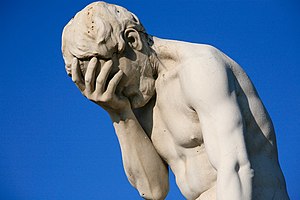
A facepalm is the physical gesture of placing one's hand across one's face, lowering one's face into one's hand or hands or covering or closing one's eyes. The gesture is often exaggerated by giving the motion more force and making a slapping noise when the hand comes in contact with the face. The gesture is found in many cultures as a display of frustration, disappointment, exasperation, embarrassment, horror,[2] shock, surprise, exhaustion, sarcasm, shame, or incredulous disbelief.[3]
- ^ Twenty-first-century Perspectives on Nineteenth-century Art: Essays in Honor of Gabriel P. Weisberg p246 Associated University Presse, 2008
- ^ Maxwell, Kerry (4 Jul 2011). "facepalm". BuzzWord. Macmillan Publishers. Retrieved 22 Nov 2011.
- ^ Taylor, Kimberly Hayes (9 August 2011). "Stressed brokers can't keep their hands off their faces. Why?". NBC News. Archived from the original on 12 September 2014. Retrieved 12 September 2014.